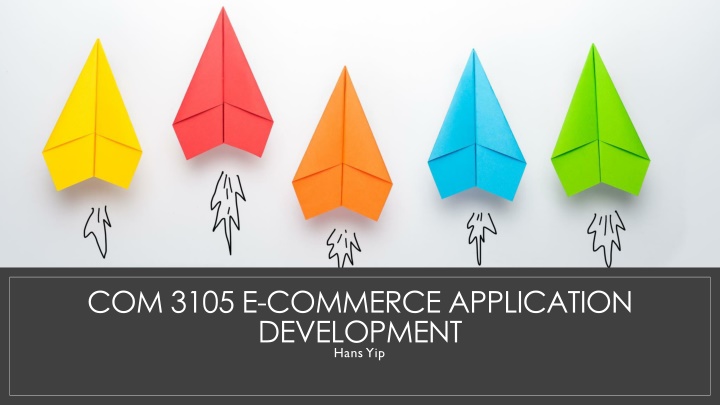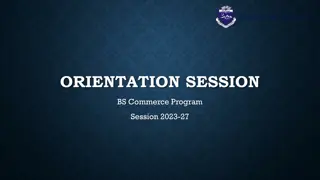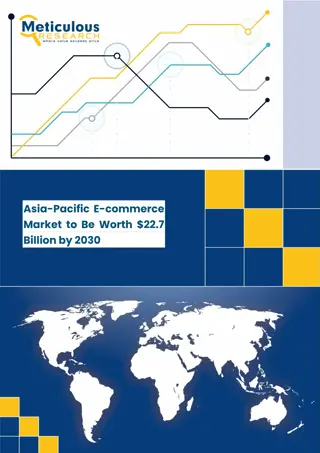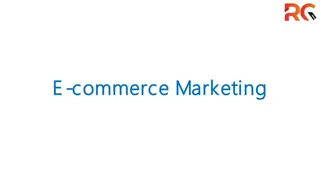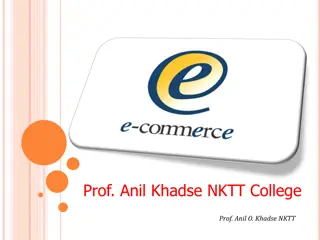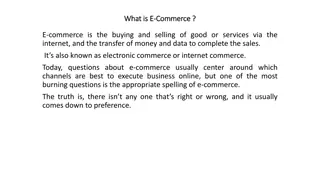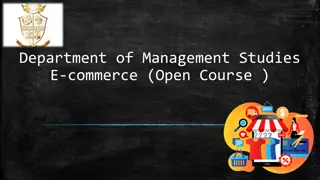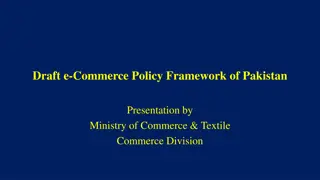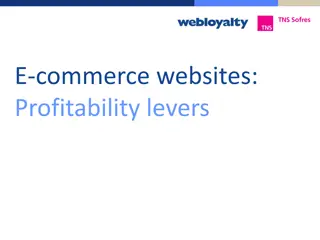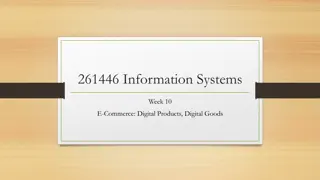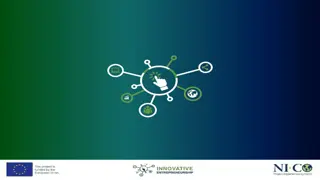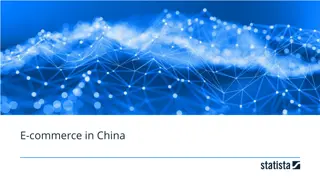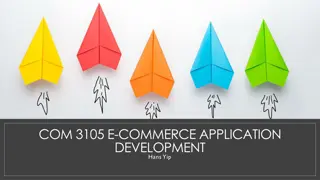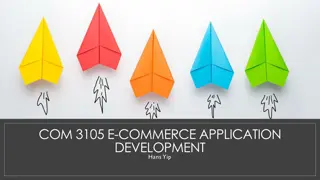E-Commerce Application Development Overview
An overview of E-Commerce Application Development and Application Programming Interface (API), including types of APIs such as Local API, Program API, and Web API. Dive into SOAP Web Services and understand how web applications communicate using XML, SOAP, WSDL, and UDDI standards. Explore the benefits of SOAP Web Services in enabling seamless communication between various web applications across different platforms without custom coding.
Download Presentation

Please find below an Image/Link to download the presentation.
The content on the website is provided AS IS for your information and personal use only. It may not be sold, licensed, or shared on other websites without obtaining consent from the author.If you encounter any issues during the download, it is possible that the publisher has removed the file from their server.
You are allowed to download the files provided on this website for personal or commercial use, subject to the condition that they are used lawfully. All files are the property of their respective owners.
The content on the website is provided AS IS for your information and personal use only. It may not be sold, licensed, or shared on other websites without obtaining consent from the author.
E N D
Presentation Transcript
COM 3105 E-COMMERCE APPLICATION DEVELOPMENT Hans Yip
Learning Objectives What is Application Programming Interface (API)? Types of API
What is Application Programming Interface (API) Application Programming Interface (API): is a software-to-software interface, not a user interface. With API, applications talk to each other without any user knowledge or intervention. Note: Main goal of API is code/program reusable. An API resembles Software as a Service (SaaS), since software developers don t have to start from scratch everytime they write a program. Instead of building one core application that tries to do everything, the same application can contract out certain responsibilities to remote software that does it better.
Request App A App B What is API? Response Client Server
Types of API Local API: is the original form of API which is the OS APIs that provide services to application programs (Front-end/GUI) requesting services or data from the back-end such as voice service or data from DB. Program API: is based on RPC (Remote Procedure Call) technology that making a remote program execution from another servers. SOA (Service Oriented Architecture) APIs are sample of Program API. Web API: also known as Web Service, is application/device communicate to each others via World Wide Web (HTTP architecture). There are two kinds of Web Service: SOAP (Simple Object Access Protocol) and RESTful (REpresentational State Transfer)
What is SOAP Web Service? SOAP Web Service: describes a standardized way of integrating Web-based applications using the XML, SOAP, WSDL and UDDI open standards over an Internet protocol backbone. XML (EXtensible Markup Language) is used to tag the data. SOAP (Simple Object Access Protocol) is used to transfer the data. (XML-based messaging protocol) WSDL (Web Services Description Language) is used for describing the services available. (Written in XML) UDDI (Universal Description, Discovery, and Integration) is used for listing what services are available (XML-based registry)
What is SOAP Web Service? NOTE: Web services allow different web applications from different sources to communicate with each other without time- consuming custom coding and because all communication is in XML. Web services are not tied to any one operating system or programming language. For example, Java can talk with Perl, Windows applications can talk with UNIX applications.
SOAP SOAP Web Service App B App A SOAP Server XML Client
What is RESTful Web Service? RESTful (REpresentational State Transfer) Web Service: also known as RESTful API, is based on REST technology which is an web application that uses HTTP requests to GET, PUT, POST and DELETE data. REST technology is generally preferred to the more robust Simple Object Access Protocol (SOAP) technology because REST leverages less bandwidth, making it more suitable for internet usage. With cloud use on the rise, APIs are emerging to expose web services. REST is a logical choice for building APIs that allow users to connect and interact with cloud services.
HTTP RESTful Web Service App B App A HTTP Server JSON Client
REST vs SOAP Web Services REST Web Services: RESTful web services are stateless. You can test this condition by restarting the server and checking if interactions survive. For most servers, RESTful web services provide a good caching infrastructure over an HTTP GET method. This can improve the performance if the information the service returns is not altered frequently and is not dynamic. REST is useful for restricted-profile devices,such as mobile, for which the overhead of additional parameters are less (e.g., headers). REST services are easy to integrate with existing websites and are exposed with XML so the HTML pages can consume the same with ease. There is little need to refactor the existing site architecture. As such, developers are more productive because they don't need to rewrite everything from scratch; instead, they just need to add on the existing functionality. A REST-based implementation is simple compared to SOAP. REST does not enforce any message format such as XML or JSON. Whereas, SOAP is XML based messaging protocol.
REST vs SOAP Web Services SOAP Web Services: The Web Services Description Language (WSDL) describes a common set of rules to define the messages, bindings, operations and location of the service. WSDL is akin to a contract to define the interface that the service offers. SOAP web services, such as JAX-WS, are useful for asynchronous processing and invocation. SOAP supports several protocols and technologies, including WSDL, XSDs and WS- Addressing.
API Economy API economy (application programming interface economy): is a general term that describes the way application programming interfaces (APIs) can positively affect an organization's profitability . AnAPI is a customer interface for technology products that allows software components to communicate. There was a time when only software professionals knew about APIs. Today, business leaders are aware of the financial impact APIs can have and companies are generating revenue by exposing APIs as business building blocks for third party applications. The emerging financial effects of APIs on businesses have gained steam thanks in part to mobile and social media technologies.Major companies that have gained revenue from APIs include SalesForce.com, Amazon, Facebook, Twitter, and Google.
Paypal API Payment Sample PaypalAPI payout process : is a backend payment process (B2B). It involves three steps: 1. Get access_token: This step is retrieved access_token from the business unit using developer s business account <client_id>:<secret_id>. 2. Modify create_payout API: Copy access_token from step 1, and enter recipient phone, recipient email, and recipient merchant_id (data should be copied from sandbox business account). 3. Execute create_payoutAPI: Execute create_payout API on a Linux platform. NOTE: Access_token may only valid for x number of hours, therefore, need to generate a new access_token by running the get-access-token API. Windows curl can only process read command, but cannot perform update. So, this process can only do it in Linux.
